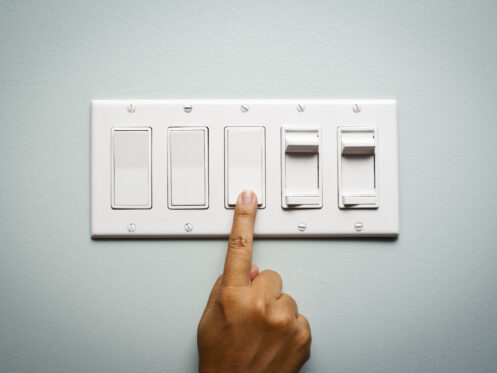Having electrical issues in your home can be dangerous, but even more so during the cold winter months. During the winter months, most households use more electricity. This could be to heat homes, to create an aesthetic with holiday lights, to power personal devices, or for other reasons. Regardless of the reason, you want to make sure your electrical system is safe for your family. Here are some of the more common issues that you could face during the winter and tips you can follow to prevent them from occurring.
Frequent Light Flickering
As the weather becomes more chaotic, you might notice that your lights are beginning to flicker. While storms often play havoc with the power grid, it’s also possible that the cause is coming from within your home. As it gets colder, we tend to overload our electrical systems by using more appliances or electrical heating systems, which may cause lights to flicker due to the additional power draw.
Additionally, as the temperature plummets, older and damaged wiring tends to become more prone to fluctuations and issues, which will cause the lights to flicker.
How to Prevent Light Flickering
While there is little potential prevention of light flickering caused by storms, etc., when it’s a connection issue within your home, you can potentially prevent this problem. Make sure you’re using lightbulbs rated for cold temperatures. Not all are designed for cold weather, and having these in a basement or a colder area of the home can result in flickering lights. Also, check outlets to determine if there is excess dust or debris. If there is, simply wipe them clean with a moisture- and static-free cloth.
If the issue stems from an overload of the system, you can distribute the load across your home. Effectively, you can power your appliances using different circuits throughout your home so that one particular circuit doesn’t get overwhelmed.
Always remember that flickering lights can be a sign of something dangerous. When this occurs, loose connections or electrical issues could be causing overheating or even electrical arcing. If you’ve tried cleaning off your outlets and spreading the load and you are still experiencing flickering, contact us at General Air Conditioning & Plumbing today. We can pinpoint the origin of the issue and minimize repair costs to make it manageable.
Power Overloads Are Becoming More Common
Similarly to excess flickering, power overloads can be caused by assigning too many electrical appliances to a circuit. When a power overload occurs, wires can heat up and actually melt. This is extremely dangerous and often leads to fires. These are identified by buzzing sounds or strange odors emanating from outlets.
Usually, these kinds of overloads are caused by running more power-draining appliances through a single circuit. Here are a few examples of the kinds of appliances that can cause power overloads:
- Microwaves
- Refrigerators
- Air conditioners
- Hair dryers
- Electrical ovens
- Space heaters
- Clothes dryers
- Electric irons
How to Prevent Overloading Your System
Similarly to light flickering, the potential for power overloads can easily be mitigated by distributing appliances across multiple circuits. If this isn’t always a viable solution, consider unplugging appliances that aren’t in use and simply plugging them in when needed.
Sparking Outlets
Sometimes, when you’re plugging into or unplugging from an outlet, you will see an electrical spark. While this might seem harmless, caution is always the best course of action. This kind of spark can be a sign of a greater electrical issue that results from the outlet getting too hot. When high temperatures are reached at the outlet due to a wide variety of factors, the protective coating on the wire can melt away. This causes electricity to jump through the bare wires, which will cause a fire hazard.
How to Keep Your Outlets From Sparking
If you’re noticing frequently sparking outlets, it’s time to contact a professional at General Air Conditioning & Plumbing. Sparking outlets definitely represent a fire risk, and if your outlets cease working at all, then this could indicate a problem as well that our electricians at General Air Conditioning & Plumbing can resolve.
An Overabundance of Extension Cords and Power Strips
With many people spending more time at home during the winter months, it’s more common for the electrical draw to increase. Christmas trees and lights add a lot of extra outlet use to what is typical in a home during the warmer months. In addition, many people look to add power strips and extension cords to power and charge their personal devices as it gets colder. Stacking excess extensions or power strips adds a hazard because too many connections introduce higher risks of instability in the connections they create.
How to Prevent Extension Cord and Power Strip Bloat Hazards
To prevent this potentially hazardous situation, always inspect your extension cords and power strips for damage. Also, try to always keep the number of attached devices to a minimum. The fewer direct connections between a device and an outlet, the lower the risk of fire. Never daisy chain multiple extension cords or power strips – seek out other outlets if needed.
Never place these connections directly on carpets and avoid any nearby heat sources as these can cause inadvertent damage to wires and the internal circuitry of the power strip. Finally, if you’re not using the cord or power strip, unplug it. Having no power going through these devices will reduce the potential for overload and damage.
Damaged Wires
Wires wear down over time, especially if pests have had the opportunity to chew on the exterior of the wires to expose the inner workings of your electrical system. When the wires behind the walls become too damaged, this fraying in the walls risks an electrical fire. These frayed wires also have a chance to electrocute you if they are not hidden, which is a hazard you don’t want to have in your home, especially if there are children present.
How to Prevent Your Wires From Being Damaged
One way to make sure your wires are not damaged is to check your wiring and look for stains along the exterior of the wire. They can be brown or black in color often resulting from a newly formed electrical burn, and wires with these marks will need to be replaced. About 13% of all home electrical fires start because of damaged or outdated wires. At General Air Conditioning & Plumbing, we can easily take care of your repair needs by section or rewire your home with new wiring.
Schedule an Inspection Today
Serving the Palm Springs community for over 40 years, General Air Conditioning & Plumbing has been one of the go-to companies for Southern California’s electrical, plumbing, and HVAC needs. We can repair your furnace, clean your air conditioning ducts, and rewire the electricity in your home. For any maintenance needs or to simply schedule an inspection to make sure all of your electrical wiring is safe, contact us at General Air Conditioning & Plumbing today to get started!


